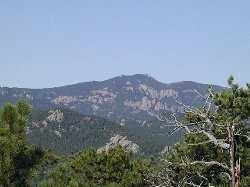Black Hills
|
|
Missing image Wpdms_nasa_topo_black_hills.jpg The Black Hills are shown highlighted on a map of North America |
The Black Hills are a small, isolated mountain range rising from the Great Plains of North America in western South Dakota and extending into Wyoming. Set off from the main body of the Rocky Mountains, the region is somewhat of a geological anomaly. The region is considered sacred by the Native Americans of the plains.
| Contents |
History
After the discovery of gold in the 1870s, the conflict over control of the region sparked the last major Indian Wars on the Great Plains. The Black Hills are considered by the Sioux to be the axis mundi, or center of the world; a treaty (the Treaty of Fort Laramie) had granted them ownership of the mountain range before the discovery of gold.
Following the defeat of the Sioux and their allies in 1876, the United States "purchased" the region (no actual purchase was ever completed and this area is under dispute to this day). In 1980, the U.S. Supreme Court ruled that the Black Hills were illegally taken and that remuneration of the initial offering price plus interest — over $100 million — be paid. However, the Lakota wanted the return of their land rather than money, and refused the settlement. The Lakota Nation still demands its land back to this day and, with the help of former Senator Bill Bradley of New Jersey, did attempt to introduce a bill into Congress for return of a portion of the Black Hills. The bill eventually failed due to lack of support from the South Dakota congressional delegation.
In the gold rush of 1877-1878, thousands of miners went to the Black Hills, and in 1880 there had already sprung into existence three towns: Deadwood, Central City, and Lead. Around these also lay groups of smaller towns and villages. From 1880 the gold mines yielded about $4,000,000 annually, and the silver mines about $3,000,000 annually.
Geology
The geology of the Black Hills is complex. A Tertiary mountain-building episode is responsible for the uplift and current topography of the Black Hills region. This uplift was marked by volcanic activity in the northern Black Hills. The southern Black Hills are characterized by Precambrian granite, pegmatite, and metamorphic rocks that comprise the core of the entire Black Hills uplift. This core is rimmed by Paleozoic, Mesozoic, and Cenozoic sedimentary rocks.
Tourism
The region is home to Mount Rushmore National Memorial, Wind Cave National Park, Jewel Cave National Monument, Harney Peak (the highest point in South Dakota), and Crazy Horse Memorial (the largest sculpture in the world).
Black Hills in film
Several major motion pictures have been filmed in the Black Hills including North by Northwest, How the West was Won, A Man Called Horse, and Dances with Wolves. The Black Hills is also the setting for the popular HBO series Deadwood, although the show is actually filmed in California.
Source: The Americana
| Regions of South Dakota | 
|
|---|---|
| Black Hills - Coteau des Prairies | |
| Largest cities | |
| Aberdeen | Belle Fourche | Brandon | Brookings | Canton | Ellsworth | Hot Springs | Huron | Madison | Mitchell | Mobridge | Pierre | Rapid City | Rapid Valley | Sioux Falls | Spearfish | Sturgis | Vermillion | Watertown | Winner | Yankton | |
| Counties | |
| Aurora - Beadle - Bennet - Bon Homme - Brookings - Brown - Brule - Buffalo - Butte - Campbell - Charles Mix - Clark - Clay - Codington - Corson - Custer - Davison - Day - Deuel - Dewey - Douglas - Edmunds - Fall River - Faulk - Grant - Gregory - Haakon - Hamlin - Hand - Hanson - Harding - Hughes - Hutchinson - Hyde - Jackson - Jerauld - Jones - Kingsbury - Lake - Lawrence - Lincoln - Lyman - Marshall - McCook - McPherson - Meade - Mellette - Miner - Minnehaha - Moody - Pennington - Perkins - Potter - Roberts - Sanborn - Shannon - Spink - Stanley - Sully - Todd - Tripp - Turner - Union - Walworth - Yankton - Ziebach |

